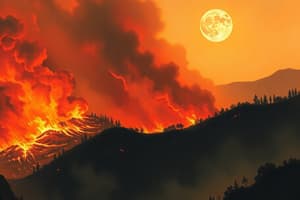Podcast
Questions and Answers
What geographical features are responsible for the formation of Santa Ana winds?
What geographical features are responsible for the formation of Santa Ana winds?
- The Great Basin and the Mojave Desert
- The Rocky Mountains and the Sierra Nevada (correct)
- The Great Plains and the Atlantic Ocean
- The Pacific Ocean and the Colorado River
Why do the Santa Ana winds gain speed as they move toward California?
Why do the Santa Ana winds gain speed as they move toward California?
- As they flow from high to low pressure (correct)
- Due to the flat terrain in California
- Because of high humidity in California
- As they flow from low to high pressure
What causes the air associated with Santa Ana winds to warm up as it descends downslope?
What causes the air associated with Santa Ana winds to warm up as it descends downslope?
- Compression due to downslope movement (correct)
- Adiabatic cooling near mountains
- Convection caused by humidity
- Expansion due to low pressure
Why does the humidity of the air decrease significantly during Santa Ana wind events?
Why does the humidity of the air decrease significantly during Santa Ana wind events?
Which other region experiences similar weather events to the Santa Ana winds?
Which other region experiences similar weather events to the Santa Ana winds?
What is a characteristic of the air associated with Santa Ana winds in terms of humidity?
What is a characteristic of the air associated with Santa Ana winds in terms of humidity?
What is one of the reasons why the Santa Ana winds are named as such?
What is one of the reasons why the Santa Ana winds are named as such?
What causes the Santa Ana winds to gain speed as they move towards California?
What causes the Santa Ana winds to gain speed as they move towards California?
Why are the Santa Ana winds often considered swift?
Why are the Santa Ana winds often considered swift?
What causes the humidity values associated with the Santa Ana winds to plummet?
What causes the humidity values associated with the Santa Ana winds to plummet?
What distinguishes the Santa Ana winds from other types of winds like chinooks and foehn winds?
What distinguishes the Santa Ana winds from other types of winds like chinooks and foehn winds?
What is one result of the airflow caused by neighboring differences in pressure during a Santa Ana event?
What is one result of the airflow caused by neighboring differences in pressure during a Santa Ana event?
Flashcards
Santa Ana winds formation: Geography?
Santa Ana winds formation: Geography?
Rocky Mountains and Sierra Nevada.
Santa Ana Winds: Speed Increase?
Santa Ana Winds: Speed Increase?
Air flows from high to low pressure.
Santa Ana winds: Warming cause?
Santa Ana winds: Warming cause?
Compression as air descends.
Santa Ana winds: Humidity decrease?
Santa Ana winds: Humidity decrease?
Signup and view all the flashcards
Similar winds?
Similar winds?
Signup and view all the flashcards
Santa Ana winds: Humidity?
Santa Ana winds: Humidity?
Signup and view all the flashcards
Santa Ana: Origin of the name?
Santa Ana: Origin of the name?
Signup and view all the flashcards
Santa Ana winds: Speed Increase?
Santa Ana winds: Speed Increase?
Signup and view all the flashcards
Santa Ana winds swift?
Santa Ana winds swift?
Signup and view all the flashcards
Santa Ana: Plummeting humidity?
Santa Ana: Plummeting humidity?
Signup and view all the flashcards
Santa Ana winds: Unique?
Santa Ana winds: Unique?
Signup and view all the flashcards
Santa Ana: Airflow result?
Santa Ana: Airflow result?
Signup and view all the flashcards





